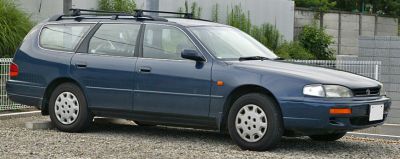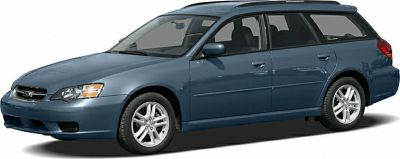 1996 Nissan Stagea Dimensions, Size & Specs
1996 Nissan Stagea Dimensions, Size & SpecsMeasurements of the 1996 Nissan Stagea, engineered for optimal performance and comfort
| Dimensions | |
|---|---|
| Length: | 4800 mm189.0 in15.7 ft |
| Width: | 1755 mm69.1 in5.8 ft |
| Height: | 1490 mm58.7 in4.9 ft |
| Weight Specifications | |
| Curb Weight: | 1430-1620 kg3153-3571 lbs |
| Tire Specifications | |
| Tire Sizes: |
|
The Nissan Stagea, produced from 1996 to 2001, is a versatile station wagon that combines spaciousness with practical design. Measuring 4800 mm (189 inches) in length, 1755 mm (69.1 inches) in width, and 1490 mm (58.7 inches) in height, the Stagea offers roomy interior space and a balanced road presence typical of late 1990s Japanese station wagons. Weighing between 1430 kg and 1620 kg (3153 - 3571 lbs) depending on the trim and equipment, it maintains a manageable weight that ensures both stability and fuel efficiency. The Nissan Stagea's tire options include 195/65 R15 and 205/60 R15, providing adequate grip and comfort for everyday driving. This generation of the Stagea reflects Nissan's emphasis on creating a family-friendly vehicle that does not compromise on size or usability, suitable for drivers seeking a reliable, spacious wagon for urban and suburban use.
Discover the standout features that make the 1996 Nissan Stagea a leader in its class
Have a question? Please check our knowledgebase first.
The Nissan Stagea from the 1996-2001 generation measures 4800 mm (188.98 inches) in length, 1755 mm (69.09 inches) in width, and 1490 mm (58.66 inches) in height. These dimensions provide a balanced size typical of mid to large station wagons, allowing ample interior space for passengers and cargo while maintaining manageable proportions for urban driving and parking. The length contributes to the car's spacious cabin and cargo area, making it suitable for families or those needing extra luggage capacity. Its width and height aid in comfort and driving stability, with a low profile that supports aerodynamic efficiency and ease of maneuvering.
The curb weight of the Nissan Stagea produced between 1996 and 2001 ranges from approximately 1430 kg to 1620 kg (3153 to 3572 pounds). This weight variation depends on the specific trim level, engine configuration, and optional equipment installed. A curb weight within this range signifies that the Stagea has a solid build and incorporates features balancing performance with safety and comfort. The lighter versions tend to offer slightly better fuel efficiency and handling dynamics, while the heavier models may include more advanced features or engines that increase overall mass.
The Nissan Stagea from the 1996-2001 generation typically uses tire sizes 195/65 R15 and 205/60 R15. These tire dimensions are designed to balance ride comfort, grip, and handling characteristics suitable for its station wagon form. The 15-inch wheel diameter is a common standard that provides a good compromise between ride quality and performance, while the tire width and aspect ratios contribute to vehicle stability and road-holding ability in various driving conditions.
With a length of 4800 mm (approximately 4.8 meters or 188.98 inches), a width of 1755 mm (1.755 meters or 69.09 inches), and a height of 1490 mm (1.49 meters or 58.66 inches), the Nissan Stagea fits comfortably inside most standard garages. Standard residential garages are typically designed to accommodate cars up to about 5200 mm (17 feet) in length and around 2400 mm (8 feet) in width, so the Stagea's dimensions are well within these limits. Despite its relatively large station wagon size, proper care when parking is needed, like with any vehicle approaching 5 meters in length, but it generally should not pose any unusual difficulty for standard garage storage.
The Nissan Stagea 1996-2001 generation is actually the first generation of this model, meaning there is no predecessor to compare in terms of dimensions. This generation set the standard for what would define the Stagea lineup. It was introduced as a unique offering in Nissan's range, positioning itself as a sporty, luxurious station wagon, often seen as a counterpart to sports sedans but with additional practicality. Hence, there is no prior Nissan Stagea generation for dimension comparison; this 1996 model introduced its distinct size and style characteristics that influenced future iterations and competitors.
When compared to similar station wagons from the mid to late 1990s, the Nissan Stagea 1996-2001 is competitive in both size and practicality. Its length of 4800 mm (188.98 inches) places it among mid to large-sized wagons, offering generous interior space relative to many competitors. Width of 1755 mm (69.09 inches) is moderate, enhancing maneuverability without sacrificing cabin room. Its versatility as a family or sports-oriented wagon was notable, bringing a blend of comfortable passenger space, cargo capacity, and sporty handling not always matched by larger European estates or more utilitarian wagons of the time. Additionally, its styling and available drivetrain options often gave it an edge in driver appeal beyond pure practicality.
While exact interior volumes for the Nissan Stagea 1996-2001 are not always standardized internationally, its dimensions as a large station wagon allow for substantial passenger and cargo space. The 4800 mm length and station wagon body style ensure a roomy cabin with ample legroom and headroom for both front and rear passengers. The cargo area behind the rear seats is large, with the option to fold seats down for even greater storage capacity. This flexibility makes the Stagea ideal for family use, long road trips, or transporting larger items, combining comfort with utility effectively during its production years.
The Nissan Stagea's height of 1490 mm (58.66 inches) strikes a balance between a low center of gravity for sportier handling and enough room for comfortable headspace inside the cabin. Compared to taller SUVs or crossovers, this relatively low height improves aerodynamic efficiency and stability when cornering, contributing to a more engaging driving experience. Practically, the moderate height still allows ease of entry and exit for most passengers without the elevated step-in height of an SUV. Additionally, the vehicle remains compatible with height-limited parking structures, an advantage for urban and suburban drivers.
The curb weight of the Nissan Stagea from this generation ranges between 1430 kg and 1620 kg (3153 to 3572 pounds), which affects both its performance and fuel consumption. A lighter curb weight typically results in better acceleration, nimble handling, and improved fuel economy, whereas the heavier variants may include additional comfort, safety features, or more powerful engines that increase the overall mass. The broad weight range shows the variation within the lineup, allowing buyers to choose between sportier, lighter trims or more equipped, heavier versions. This flexibility enabled the Stagea to appeal to drivers seeking either balanced daily usability or enhanced performance capabilities.
The Nissan Stagea produced between 1996 and 2001 is typically equipped with 195/65 R15 or 205/60 R15 tires. These sizes reflect a focus on ride comfort and stability, with the 15-inch rims providing a smooth ride by better absorbing road imperfections compared to larger wheels. The tire widths 195 mm and 205 mm offer good road grip without sacrificing fuel efficiency or increasing road noise excessively. Furthermore, the aspect ratios (65% and 60%) ensure a reasonable sidewall height, which contributes to shock absorption and contributes to the vehicle's balanced driving dynamics on various surfaces.
Discover similar sized cars.

| Production: | 1980-1982 |
|---|---|
| Model Year: | 1981 |
| Length: | 4732 mm186.3 in |
| Width: | 1722 mm67.8 in |
| Height: | 1470 mm57.9 in |

| Production: | 2002-2006 |
|---|---|
| Model Year: | 2002 |
| Length: | 4775 mm188.0 in |
| Width: | 1760 mm69.3 in |
| Height: | 1475 mm58.1 in |

| Production: | 1991-1996 |
|---|---|
| Model Year: | 1992 |
| Length: | 4820 mm189.8 in |
| Width: | 1770 mm69.7 in |
| Height: | 1475 mm58.1 in |

| Production: | 1991-1996 |
|---|---|
| Model Year: | 1991 |
| Length: | 4795 mm188.8 in |
| Width: | 1770 mm69.7 in |
| Height: | 1505 mm59.3 in |

| Production: | 2006-2009 |
|---|---|
| Model Year: | 2006 |
| Length: | 4795 mm188.8 in |
| Width: | 1730 mm68.1 in |
| Height: | 1475 mm58.1 in |
